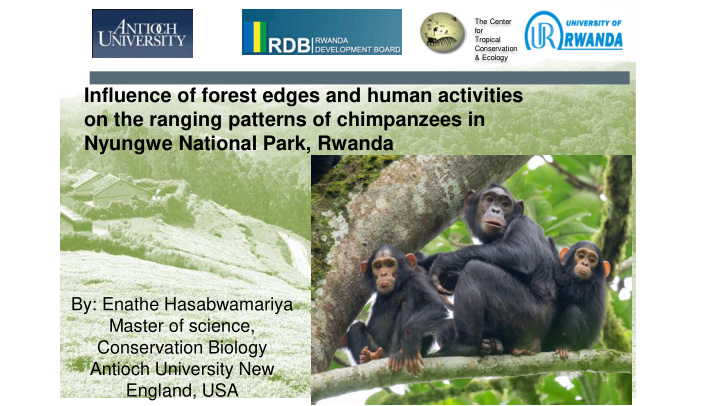



The Center for Tropical Conservation & Ecology Influence of forest edges and human activities on the ranging patterns of chimpanzees in Nyungwe National Park, Rwanda By: Enathe Hasabwamariya Master of science, Conservation Biology Antioch University New England, USA
Nyungwe National Park Surface area: 1,015 sqkm ………………………….
Rich Biodiversity 13 species of Primates 280 species of birds 100 species Reptile Small mammals Source of Nile River (70%of Rwanda’s water comes from Nyungwe)
Why Chimpanzees? Closest-relatives Endangered species( IUCN) Economic importance through ecotourism. Ecologic importance through seed dispersal capacity and forest regeneration
The conservation challenge
Why forest edges? Attractions: Diversity of food species, nutritious food, food from from agriculture (agroforestry, beekeeping, etc..). Threats: Disease transmission, illegal activities, human and wildlife conflicts.
Edge effect? Changes or disturbances at the boundary between two habitats. Abiotic factors : Temperature, Wind penetration, soil moisture, fire frequency and intensity. Biotic factors : species composition, invasive species, etc..
Type of edges around Nyungwe 1. Soft edges Pine Plantations Eucalyptus Plantations
2. Hard edges Tea Plantation
Previous Research: Mapping edge effect around Nyungwe
Research Objectives • Assess chimpanzee use of forest edges. • Document ecological factors influencing chimpanzee ranging patterns. • Document the influence of human activities on the ranging patterns of chimpanzees.
Study site Map by JGI
Methods – Inside the forest Edge to Interior Systematically walked 5 1-km transects perpendicular to the forest edge (edge to interior) for 3 consecutive months. Signs of chimpanzee recorded and located with GPS along transects 0-1km ( i.e. observations of chimpanzee, chimpanzee vocalizations, feeding signs, feces, nests).
Methods – Outside of the forest along human activities Systematically walked 5-1 km transects parallel to the forest edge for 3 consecutive months. Recorded all signs of chimpanzees and type of matrix and human activity.
Vegetation Sampling 30 m 1000m circular sample plots 50 950m 0 m m • Edges were defined at 0-50 meters inside the forest just along the edge. • Ten circular plots of 5meters radius were randomly located at forest edges and interior between 0-50 m, where I recorded tree species, diameter at breast height (DBH) and basal area at forest edges in the plots to compare vegetation.
Results
Chimpanzee distribution in relation to distance from edge Frequency of Distribution 400 350 300 250 Location Distance (m) Frequency Mean Distance 200 Edge 0-500 371 199.03 150 Interior 500-1000 59 692.8 100 50 0 (binom. test (100, 0.6, p=0.01)) Edge Interior
Beehives destroyed by chimpanzees
Conclusion Chimpanzees were mostly found using forest edges compared to forest interior I found a significant positive relationship between fruits availability and chimpanzee's distribution at the forest edges Beekeeping was the main attraction of chimpanzees outside the park
Recommendations More research are needed to better understand the socio-ecological behaviors of chimpanzees and their interactions with humans. Collaboration between researchers, local communities, and policy makers is needed to reduce human- chimpanzee conflicts. Modern beekeeping practices are needed to support communities in Gisovu and reduce human-chimpanzee conflicts
THANK YOU!!
Recommend
More recommend